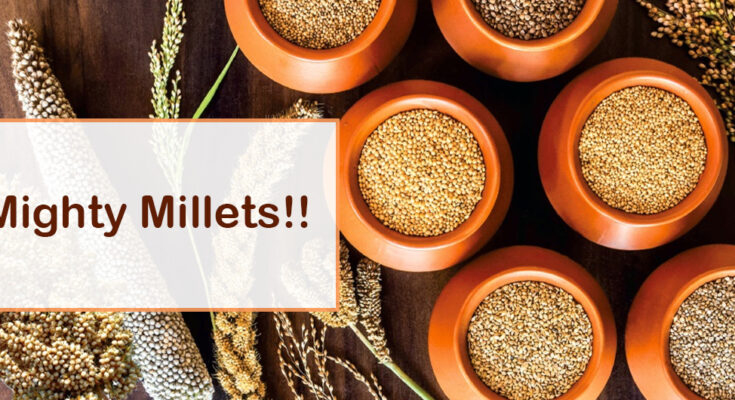Millets originated in China at least 5,000 years ago and have been a staple diet in India (and some regions of Africa) for many centuries. In India, nine different types of millets, including sorghum, finger millet, tiny millet, kodo millet, foxtail millet, and barnyard millet, are grown in various forms. They have a range of colors, sizes, and textures but essentially the same nutritious makeup.
In addition, each of them has a local name in various Indian languages, demonstrating their historical appeal throughout geographies.
Following an initiative from India, the United Nations has proclaimed 2023 the “International Year of Millet.”
Rural India’s millet-based meal tradition was preserved by women passing on their knowledge of these recipes to future generations.
Millets are now gradually making their way back into Indian diets across the social spectrum, from wealthy customers looking for trendy foods (like quinoa and kale) in their drive the well-being of middle-class mothers ingeniously slipping the healthy grains into family meals.
What Exactly Is Millet?
Millets are dramatically different little grasslands that are widely farmed to produce cereal crops worldwide. The slightly rounded millet sprouts are in white, green, yellow, and red varieties.
They are incredibly nutrient-dense. Regarding proteins, mineral deposits, and vitamin supplements, millet is three to five times more nutrient-dense than wheat and rice.
Millets have a high vitamin B, calcium, iron, potassium, magnesium, and zinc level while being gluten-free.
Millets are excellent for people who are intolerant to grains because they have a low GI. Weight loss in millet can be advantageous for people with diabetes.
There’s One for Everyone!!
More than 500 kinds of millet are within the main categories, despite the common misconception that millet is a single-grain variety.
Pearl Millet
Pearl millet, also known as Bajra, is one of the most popular millets. It provides health advantages and can be prepared in various ways, including paratha and khichdi.
Iron, fiber, protein, and mineral deposits like calcium and magnesium are all present in bajra. Frequent use of pearl millet has health benefits, including helping you fight type 2 diabetes.
Sorghum Millet
Another type of millet frequently used in India to produce chapatis and other baked foods is sorghum millet. In India, it is known as jowar. Natural jowar is a healthy source of iron, protein, and fiber and may help lower cholesterol.
For those who are allergic to wheat, jowar is a healthier alternative. Jowar is abundant in calories and macronutrients and has antioxidant qualities superior to berries and pomegranates.
Sorghum aids in enhancing metabolic activity.
Buckwheat
Buckwheat is a type of millet typically consumed during the fasting days of Navratri. In India, it is also referred to as kuttu. Moreover, it helps to decrease blood pressure and is suitable for people with diabetes diabetics. If you want to reduce weight, including it in your diet is essential.
Foxtail Millet
Semolina and rice flour are the two most common forms of foxtail millet, sometimes called Kakum or Kangni in India. It contains a lot of carbohydrates, which help the body regulate blood sugar levels. These millets contain a lot of iron. The immune system of the entire body can be strengthened with foxtail millet.
Finger Millet
Ragi is another name for finger millet. Fitness enthusiasts frequently consume it as a healthy rice or wheat alternative.
It is a gluten-free millet variant that provides a substantial amount of protein. Finger millet is traditionally believed to promote brain development in young children.
Also, it is nutrient-rich and has enough iron and other mineral reserves. In addition to having a strong antioxidant capacity, ragi also contain significant levels of the essential amino acids the body needs.
Sanwa Millet
Sanwa is another name for the well-known millet variety, Barnyard Millet. It has many dietary fibers, promoting weight loss and digestive movement. It has a lot of calcium and phosphate, which can increase bone mass.
The fastest-growing plant, barnyard millet, produces ripe grains 45 days after planting in ideal meteorological conditions.
Amaranth Millet
This millet is high in fiber and protein. It is advantageous to a balanced diet. Also, this millet helps with hair loss and graying prevention. Moreover, amaranth may lower cholesterol levels and heart disease risk. It contains a lot of calcium, vitamin supplements, and mineral deposits.
Samai Millet
Samai is another name for the vital millet known as little millet. It contains calcium, potassium, iron, zinc, and vitamin B minerals.
The southern states of India frequently use little millet in numerous traditional dishes. It is far healthier than rice and won’t make you gain weight.
Proso Millet
Because it has a low GI, proso millet helps maintain a healthy blood sugar level. For people with diabetes, incorporating it into their daily diet is a great option. Nutrient transitioning can be made more accessible by switching to a millet-based diet.
Kodo Millet
The absorbable variety with higher levels of the amino emulsifier is Kodo millet, also known as Kodon millet. The central nervous system’s adaptability is significantly impacted. Niacin, B6, folic acid, and other minerals and vitamins, including vitamin B, are all crucially important and can be found in kodo. It contains calcium, iron, magnesium, potassium, and zinc.
Considering that it is gluten-free, it is ideal for those who have celiac disease. It helps improve heart conditions like high blood pressure and cholesterol when postmenopausal women consume it frequently.
It’s Time to Get These Mighty Millets in Your Diet
The inclusion of millet in your diet is one of your greatest options!
They provide your body with the fuel it needs for the day while positively affecting your health. You can choose from various millets and begin cooking items that are so unbelievably fresh and delicious that you’ll be in awe!
Millets contain considerable amounts of essential nutrients; each millet will have a distinct flavor and health benefits. You can select the ideal millet for you and your family now that you understand the many millets.
See how much difference it makes by trying natural millet instead of rice or wheat.
Let’s get these millets in our life this “international year of millets”.




